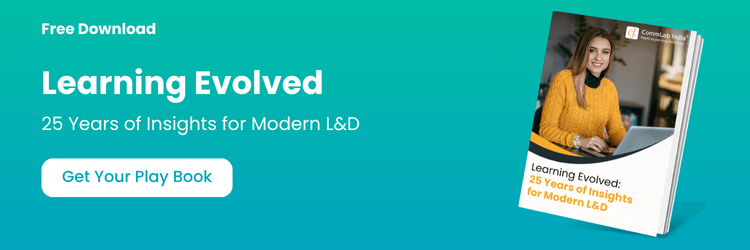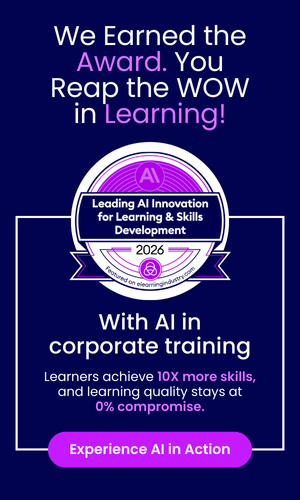Corporate learning has come a long way, from classrooms and printed manuals to digital platforms and data-driven ecosystems. Yet, the true transformation of learning hasn’t been about technology alone; it’s been about purpose. The most significant progress in the evolution of eLearning came when training began aligning directly with business outcomes, driving performance, productivity, and measurable results.
In our ongoing series on the Evolution of eLearning, we’ve traced this journey through its major milestones.
In Stage 1: Traditional Training, we explored how instructor-led classrooms built the foundation for corporate learning, offering structure, collaboration, and human connection, but limited in reach, scalability, and consistency.
Stage 2: Digitization of Content took that foundation online. Organizations began converting classroom materials into digital formats: slides, manuals, and lectures became eLearning modules. It brought flexibility and accessibility, but many programs remained content-heavy and disconnected from real business goals.
Now we move to the next phase, Stage 3: Strategic eLearning, the turning point when Learning and Development (L&D) evolved from a support function to a strategic business partner. This was the stage when learning became measurable, scalable, and tied directly to performance and organizational success.
Download Play Book: 25 Years of Insights for L&D Leaders
Table Of Content
- What Is Strategic eLearning?
- How Did L&D Become a Strategic Partner?
- What Tools Drive Strategic eLearning Today?
- What Works and What Fails in Strategic eLearning?
What Is Strategic eLearning?
Strategic eLearning marks the stage where Learning and Development (L&D) truly matured, evolving from creating digital content to designing business-aligned, performance-driven learning experiences.
In this phase, learning is finally connected with strategy. Courses weren’t just digital versions of classroom sessions; they were planned, structured, and outcome-focused, designed to solve real business challenges.
L&D became a strategic partner, using models such as ADDIE and Gagné’s Nine Events of Instruction to develop scalable, measurable programs. Training wasn’t built for completion — it was built for capability.
Key Characteristics of Strategic eLearning:
1. Alignment with Business Goals: Learning initiatives were tied directly to organizational outcomes — productivity, quality, compliance, and customer satisfaction.
2. Localization for Global Impact: Courses were translated and adapted for multiple regions, ensuring relevance and inclusivity for global learners.
Explore CommLab India’s eLearning Translation Services for consistent, compliant, and engaging training across global teams
3. Instructional Design Maturity: Frameworks like ADDIE and Gagné guided content creation, ensuring structured design, engaging flow, and measurable impact.
4. Scalability and Standardization: L&D teams adopted templates and processes to deliver enterprise-wide rollouts that maintained consistency across departments and geographies.
5. Agility and Speed: Rapid authoring tools and collaborative workflows enable fast turnarounds without compromising instructional integrity.
6. Performance-Driven Approach: Focus shifted from “course completion” to real-world outcomes — improving employee competency, reducing time-to-proficiency, and driving measurable business gains.

How Did L&D Become a Strategic Partner?
As eLearning matured, organizations began expecting more from their training programs. Digital courses were everywhere, but many failed to show a clear impact on business results. Employees were completing modules, yet performance gaps remained.
This realization forced a mindset shift — learning had to prove its worth. Training could no longer be about delivering content; it had to drive outcomes.
That’s when L&D stepped up from being a course provider to becoming a business partner.
From Requests to Results
Instead of waiting for departments to ask for training, L&D began working proactively with leaders to understand business goals. The focus moved from “What course do you need?” to “What result do you want to achieve?”
Learning strategies started aligning with real business needs — whether it was improving product knowledge for sales teams, ensuring compliance accuracy, or reducing errors on the production floor.
From Information to Experience
This period also saw a transformation in how courses were designed. Learning became structured, purposeful, and learner centric. Using models like ADDIE and Gagné’s Nine Events of Instruction, L&D teams began creating experiences that built skills and changed behavior — not just shared information.
Scenario-based training, simulations, and performance-focused assessments replaced long, static modules. Learning became more interactive, personalized, and relevant to daily work.
From Scale to Strategy
With expanding global workforces, scalability has become essential. But unlike earlier digitization efforts, this wasn’t just about quantity — it was a strategic scale.
L&D started using templates, rapid authoring tools, and localization workflows to deliver consistent, high-quality learning to thousands of employees worldwide. The goal wasn’t to launch more courses — it was to launch the right ones, faster and smarter.
The Outcome
This evolution gave L&D a new identity. It wasn’t just supporting operations anymore — it was enabling them. Learning strategies now influenced productivity, sales, safety, and even customer satisfaction.
L&D became a true partner in business performance, proving that well-designed learning could move the same metrics the C-suite cared about.
What Tools Drive Strategic eLearning Today?
What Rapid Strategies Power Strategic eLearning Success?
Strategic eLearning helps L&D deliver fast, focused results without heavy lift.
- Align goals with business outcomes from the start.
- Repurpose assets into short, interactive modules.
- Use rapid authoring tools for faster course creation.
- Localize content efficiently for global reach.
- Reinforce learning with microlearning and job aids.
Behind every successful Strategic eLearning initiative lies the right blend of design thinking and technology. Tools today are no longer just for building courses — they’re the engines that make learning dynamic, personalized, and outcome-driven.
The modern L&D team uses a connected suite of tools that help them design, deliver, and continuously improve learning experiences. Each tool plays a unique role in making eLearning more engaging, interactive, and aligned with business performance.
Tools That Shape the Strategic eLearning Experience
1. Articulate Storyline 360 – Still the gold standard for interactive eLearning. Storyline helps designers create scenario-based, decision-driven experiences that go beyond click-and-read modules. It’s ideal for compliance, sales, and soft skills training where engagement and critical thinking matter.
2. Articulate Rise 360 – Perfect for modern learners on the move. Articulate Rise allows L&D teams to build responsive, modular courses that look beautiful on any device. It’s widely used for onboarding, quick updates, and microlearning paths.
3. Adobe Captivate – Best known for creating immersive simulations and responsive designs, Adobe Captivate supports strong instructional design by enabling software and technical training that lets employees “learn by doing.”
4. Lectora – A powerful choice for enterprise learning. Its robust accessibility features, custom scripting, and multi-language support make it perfect for large organizations that need flexibility and compliance.
5. AI-Powered Video Tools: Synthesia & Vyond – Video is the language of today’s workforce. Tools like Synthesia’s AI video generator and Vyond’s animation platform let teams create professional videos with avatars, voiceovers, and multilingual scripts — without relying on studios or long production cycles.
6. Learning Platforms: EffectusLMS, Docebo, Cornerstone – These systems now go beyond hosting content. They deliver intelligent insights, recommend personalized learning journeys, and connect data directly to performance outcomes. They are the analytical backbone of Strategic eLearning.
What Works and What Fails in Strategic eLearning?
Strategic eLearning isn’t about adding more digital content — it’s about creating experiences that change behavior, improve performance, and solve business problems. When done right, it becomes an engine for capability building; when done wrong, it turns into digital noise.
Yet, 94% of organizations still focus on tracking activity and completion rates, while only 4% measure true ROI — proving that most are missing the real purpose of strategic learning.
Here’s what today’s most effective learning organizations are getting right — and where many still fall short.
What Works
1. Turning Complex Technical Content into Practical Learning
In every industry, employees need to understand the “how” behind products and processes — but too often, that knowledge lives inside dense presentations and outdated decks. Strategic eLearning transforms those materials into interactive, job-ready learning.
Example in Practice A global manufacturer once relied on a 300-slide technical deck to train its sales and service teams. Learners skimmed through it, but real understanding never followed. The company rebuilt the material as short, scenario-based courses in Articulate Storyline, localized them into seven languages, and rolled them out company-wide.
Result: Time-to-competency for new hires was cut in half, and customer satisfaction scores rose sharply.
This is the essence of Strategic eLearning — distilling information into meaningful, action-oriented learning that drives measurable performance improvement.

Learning Evolved: 25 Years of Insights for Modern L&D Leaders
Get ready to:
- Benchmark your eLearning journey
- Start with what’s working for top enterprise L&D teams
- Explore self-assessments, planners, and other tools
- Much More
2. Modernizing Legacy Learning for a Modern Workforce
Many organizations still have years of valuable training locked away in formats that no longer work. Strategic eLearning keeps that knowledge alive by re-engineering legacy content instead of starting from scratch.
Example in Practice A large telecommunications company found itself with more than 1,500 legacy courses that stopped working when Flash support ended. Rather than rebuilding from zero, it used modern authoring tools such as Lectora Online to redesign and republish the courses in HTML5. A cross-functional team completed the update within months.
Result: Critical compliance and technical training continued seamlessly, now mobile-friendly and accessible anytime, anywhere.
This approach reflects the Strategic eLearning mindset — treating disruption as an opportunity to evolve, not a reason to pause.
3. Designing for Agility and Collaboration
Today’s learning teams can’t afford six-month development cycles. Using authoring tools, shared design templates, and agile review processes with subject-matter experts, leading organizations now deliver entire learning programs in weeks. The goal isn’t speed alone, but responsiveness — ensuring learning keeps pace with business change.

What Fails
1. Holding on to Outdated or Redundant Content
Old courses that linger in an LMS create confusion, not value. Learners waste time navigating irrelevant material, and compliance risks increase when obsolete information is still in use. Strategic eLearning demands regular audits and purposeful retrieval of content that no longer serves the business.
2. Neglecting Frontline Learners
Frontline employees — salespeople, technicians, service staff — have the most direct impact on customers, yet they’re often the last to receive effective learning. Strategic eLearning puts them first, delivering concise, mobile-ready resources that fit their workflow and make learning part of the job, not a distraction from it.
3. Treating Learning as a One-Off Activity
A single course rarely changes performance. Without reinforcement, feedback, or follow-up, knowledge fades quickly. Strategic eLearning replaces one-time events with ongoing learning journeys — microlearning refreshers, performance support tools, and continuous analytics that sustain impact long after launch.
What Comes After Strategic eLearning?
We’ve now explored the first three stages in the evolution of eLearning — from Traditional Training to Digitization of Content, and now Strategic eLearning, where learning design, technology, and business goals come together to deliver measurable results.
The next stage is Learning Ecosystem Leadership — where learning becomes intelligent, connected, and seamlessly integrated into everyday work through AI, analytics, and automation.
This article is part of a larger playbook that captures 25 years of evolution in corporate learning and development. It includes real-world case studies, industry benchmarks, and practical strategies to help organizations advance across every stage of eLearning maturity and build the intelligent learning ecosystems of the future. Download now.






![5 Compelling Reasons for Rapid eLearning Development [Infographic]](https://www.commlabindia.com/hubfs/Imported_Blog_Media/rapid-elearning-development-reasons-infographic.jpg)

